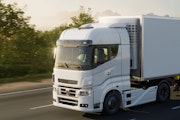How AI-powered video telematics improves fleet safety and...
As the adoption of AI-powered video telematics increases, fleets across various industries are experiencing significant...
Read more
Daytime running lights or DRLs are low-intensity lights that improve vehicle visibility on the road by increasing the contrast between vehicles and the environment.
While some research shows DRLs could improve road safety, reducing everything from pedestrian accidents to head-on collisions, they are not currently mandatory in the U.S. This article will look at what DRLs are, how they differ from regular headlights, their benefits, where they are mandated and how they impact fleet safety.
DRLs are low-intensity lights on the front of vehicles that automatically turn on when a vehicle’s engine is started.
The Federal Motor Carrier Safety Administration defines DRLs as “steady burning lamps that are used to improve the conspicuity of a vehicle from the front and front sides when the regular headlamps are not required for driving.” Unlike regular headlights, DRLs are not intended to illuminate the road but rather to make the vehicle more visible to other road users. Sometimes, these may be mistaken for headlights when you see them on the road, but the lights will typically be smaller and/or dimmer than standard headlights.
While DRLs are a safety feature that typically cannot be turned off, particularly while the vehicle is in motion, some manufacturers offer a DRL off switch that allows the driver to turn them off.
The primary benefit of DRLs is simple: Increased contrast and visibility lead to fewer collisions, particularly for vehicles that are less noticeable during daylight, or when certain daytime weather conditions like glaring sun or cloudy skies impair visibility.
Studies have shown that DRLs can reduce the risk of accidents involving other vehicles, pedestrians, cyclists and motorcyclists.
According to a study by the National Highway Traffic Safety Administration (NHTSA), DRLs reduced opposite-direction daytime fatal crashes by 5%, non-fatal crashes by 5% and pedestrian and cyclist fatalities in single-vehicle crashes by a substantial 12%. The most significant benefit of DRLs is for motorcyclists: DRLs reduced the likelihood of opposite-direction fatal collisions involving a passenger vehicle and a motorcycle by 23%. A separate NHTSA study found that daytime headlight use reduced daytime crashes from light trucks and vans by 5.7%.
However, it should be noted that in other types of crashes besides these listed, the studies found no significant benefit from DRLs.
See how fleet management software is already helping fleet safety programs, reducing accident costs and improving maintenance.
In most of Europe and Canada, DRLs are mandatory, but in the United States, they are considered optional. The Federal Motor Carrier Safety Administration allows DRLs on passenger cars, trucks and buses, but they are “permitted but not required.”
Additionally, no U.S. states currently mandate the use of DLRs, however, several states have specific rules about standard headlight usage during the day, especially in conditions that impact visibility.
State laws generally require drivers to turn on their headlights in certain weather conditions, such as heavy rain, fog or snow or when visibility is below a certain threshold, such as 500 feet. Some states keep it simple and require that drivers turn on their headlights whenever they turn on their windshield wipers. Some states also require drivers to use their headlights in construction zones, on narrow mountain passes or on winding roads.
As road safety standards evolve, it’s possible that DRLs may become a required feature on all new vehicles sold in the United States in the future. Some manufacturers currently include DRLs as standard or optional features on many vehicles to improve safety and follow trends in global automotive markets.
Because there is compelling evidence that DRLs can help reduce crashes, fleet managers may look to include them as safety features when purchasing fleet vehicles. However, because they are not federally mandated, DRLs are not always a standard vehicle feature. They may be added after-market with the help of a qualified professional.
Fleet managers looking for other ways to help boost fleet safety may want to consider a fleet management solution that empowers them to develop and maintain effective safety programs. Fleet management can help impact safety in several different ways:
Companies using fleet management software saw a reduction in accident costs and insurance costs, underlining how this technology can help fleets drive a safer tomorrow. To learn more, book a demo with one of our specialists.
Tags: Safety




Find out how our platform gives you the visibility you need to get more done.
As the adoption of AI-powered video telematics increases, fleets across various industries are experiencing significant...
Read moreFleet safety programs are a mixture of equipment and solutions for fleet driver safety...
Read moreCSA scores grades commercial carriers based on several safety-related factors and are important for carriers to understand.
Read moreLearn how to create and sustain an effective driver safety program for your fleet with 5 actionable steps. Boost safety...
Read more